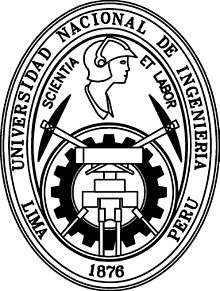National University of Engineering
The National University of Engineering (Spanish: Universidad Nacional de Ingeniería, UNI) is a public engineering and science university located in the Rímac District of Lima, Peru.
Universidad Nacional de Ingeniería | |
 UNI coat of arms. | |
| Motto | Scientia et labor |
|---|---|
Motto in English | Knowledge and work |
| Type | Public |
| Established | March 18, 1876 |
| Founder | Edward Jan Habich |
| Rector | Ph.D. Jorge Elias Alva Hurtado |
Academic staff | 900 |
| Students | 12,345 (2016) |
| Undergraduates | 10,708[1] |
| Postgraduates | 1,000 |
| Address | Av. Túpac Amaru 210, Rímac , , |
| Campus | Urban |
| Colors | Maroon |
| Affiliations | Alianza Estratégica |
| Website | www.uni.edu.pe |
History
The National University of Engineering was founded in 1876 by the Polish engineer Edward Jan Habich as the School of Civil Constructions and Mining Engineers (Spanish: Escuela de Ingenieros de Construcciones Civiles y de Minas), but has traditionally been known as School of Engineers (Escuela de Ingenieros). At the time of its foundation, there was a growing demand for engineers in Peru due to the rapid development of mining and communications.
Today, the National University of Engineering is widely regarded as the foremost science and technology-oriented university in Peru, many of its alumni occupying today positions of leadership in the fields of Industry, Academia, and Government.
Academics
Current admission is highly competitive, with ~16% acceptance rate in 2020 overall and ~500 applicants per vacancy in the most demanding study fields such as Civil Engineering, Architecture, Systems Engineering, Industrial Engineering and Mechatronics Engineering.
UNI is widely known for being rigorous, demanding great focus and effort from its students. Given the competition level to be accepted to the National University of Engineering and its highly demanding curricula, the university is commonly acknowledged as the most difficult to attend in the whole country. This has given UNI students recognition among Peruvians, but it has also created an imbalance sometimes regarding GPA's as compared to other schools, those of UNI's students being in some occasions lower due to the difficulty level being harder.
Notable alumni
Among former renowned professors and students are:
- Martin Vizcarra Cornejo, President of Peru (2018–2021).
- Fernando Belaúnde Terry, former President of Peru (1963–1968, 1980-5).
- Alberto Benavides de la Quintana. Founder of Buenaventura Mining Company. Peruvian Billionaire[2]. Mining Engineering, Class of 1941. Masters in Geology from Harvard University, Class of 1944[3].
- Miguel De La Torre Sobrevilla, founder and CEO of Geoservice Ingeniería. Former president of the board of directors of International Geosynthetics Society (IGS) in Peru.
- Francisco Sagasti, former Planning manager at the World Bank. Former President of the Consultive Council of Science and Technology for Development in the United Nations., visiting professor of the Wharton School of Business at University of Pennsylvania.[4]
- Barton Zwiebach Cantor, string theorist, author of "A First Course in String Theory" and Professor of Physics at the Massachusetts Institute of Technology. He also was awarded with the MIT School of Science 2003 Teaching Prize for Excellence in Undergraduate Education[5]
- César Gonzales, an IBM Fellow at the Thomas J. Watson Research Center and also a Fellow of the Institute of Electrical and Electronics Engineers (IEEE). He is an expert in digital image and video technologies having contributed to the development of the widely used MPEG-2 video compression standard. He also led the development of advanced semiconductor chips based on this standard which IBM sold in the digital TV broadcast and consumer electronics markets.[6]
- Edgar Perez, He is the author of The Speed Traders and Knightmare on Wall Street, and has been featured internationally on high-frequency trading, financial regulation and international economics.
Organization
UNI is organized into eleven faculties which contain twenty-seven academic departments. It is a university polarized around science, engineering, and the arts. Most of the academic departments offer a wide variety of engineering specialties, including Industrial, Mechanic, Mechatronic, Electronic Engineering, and other innovative fields more related to Social Sciences such as Economic Engineering.
| School | Department |
|---|---|
| Architecture, Urbanism and Arts Department | Architecture |
| Science Department | Physics |
| Mathematics | |
| Chemistry | |
| Engineering Physics | |
| Computer Science | |
| Environmental Engineering Department | Sanitary Engineering |
| Hygiene and Industrial Safety Engineering | |
| Environmental Engineering | |
| Civil Engineering Department | Civil Engineering |
| Economics Engineering and Social Sciences Department | Economics Engineering |
| Statistics Engineering | |
| Electrical and Electronic Engineering Department | Electrical Engineering |
| Electronics Engineering | |
| Telecommunications Engineering | |
| Mining and Metallurgical Engineering Department | Geological Engineering |
| Metallurgical Engineering | |
| Mining Engineering | |
| Industrial and Systems Engineering Department | Industrial Engineering |
| Systems Engineering | |
| Mechanical Engineering Department | Mechanical Engineering |
| Mechanic-Electrical Engineering | |
| Naval Engineering | |
| Mechatronics Engineering | |
| Petroleum Engineering and Natural Gas Department | Petroleum Engineering |
| Petro-chemical Engineering | |
| Chemical and Textile Engineering Department | Chemical Engineering |
| Textile Engineering |
References
- (in Spanish) Oficina de Registro Central y Estadística de la UNI, Student population statistics Archived 2008-03-02 at the Wayback Machine. Retrieved on December 9, 2007
- https://www.forbes.com/profile/alberto-benavides/#37c1e42f6ce0
- https://www.bnamericas.com/en/news/buenaventura-founder-alberto-benavides-dies-at-93
- "Archived copy". Archived from the original on 2007-10-08. Retrieved 2007-03-03.CS1 maint: archived copy as title (link)
- "Archived copy". Archived from the original on 2005-04-26. Retrieved 2005-05-29.CS1 maint: archived copy as title (link)
- "IBM Research People and Projects". Domino.research.ibm.com. 25 July 2016.
Sources
- "Universidad Nacional de Ingeniería". History and general reference (in Spanish). Retrieved May 25, 2005.
External links
- (in Spanish) Universidad Nacional de Ingeniería website